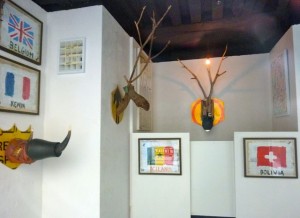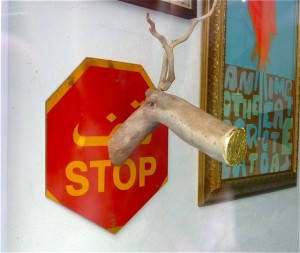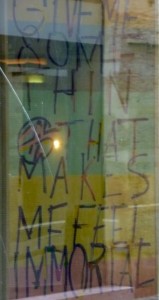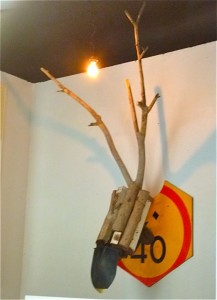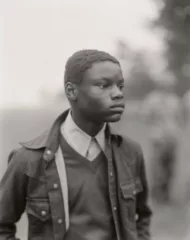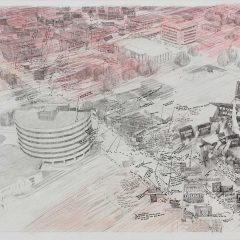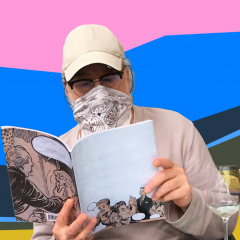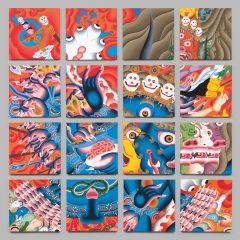“Le Zoo de Vincent” by Vincent Who at Substance in Paris stopped me in my tracks like a deer caught in headlights. Traffic signs, small logs, branches and rubber are assembled with great wit to create representations of stuffed heads from the antler class of mammal. What tickles is the transformation of the work of art into quarry to be bagged.
When mentioning bagging a work of art we think of a collector shooting money at the latest work to come out of the hottest studio. But Vincent Who’s work keeps this hunting metaphor in the studio where the artist is trying to capture, hold and materialize that moment when the art he or she has been tracking is discovered , shot and bagged. This isn’t recreational, catch and let go hunting. It is hunting for keeps. Like a hunter, the artist brings back the work from the wilderness, the wilderness of creation. By chance the work is hung on a wall or put on a pedestal as the prize and the result of relentless tracking. If it sustains us, the artist is a hero.
The works composed of wood have a peasant feel to them. They hint at a world without animals, or a world in which the animal has become a citizen with rights including the right not to be hunted–hence these sculptures. They are as basic as a log cabin. As opposed to the pig’s head in Lord of The Flies, there is no decay and there was no animal sufferring. They invoke stags and rhinos and derive their energy from this invocation. But there are no black beady eyes staring back at us and pulling us into other lights and times; just holes or knots of wood. There are no pelts, only bark and rubber skins. No animal died so that another might eat. Unless the artist is making sacrifices in order to bring this work to us? These details feed the idea that the artists creates his quarry with materials at hand and in so doing bags it.
The head composed of basketballs, a bucket and real (?) horns is especially intriguing. The choice of material suggests that Vincent Who has unleashed the animal in the objects of play. The trophy is not a silver cup but the ball transfigured into the beast the player became during the match.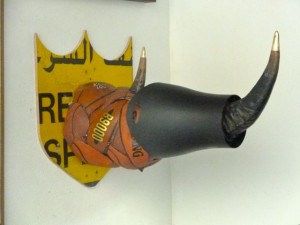
In a Damien Hirst gesture of sacralizing the object, gold leaf cauterizes the extremities of these sculptures: a shovel’s tip, the cut tip of a log, the point of a horn. The gold wraps these points of potential violence, growth and work in muteness and finality. It would have been fascinating to see these works flower. Because they won’t, the metaphor of creation as a hunt returns. More meat and art are always needed and it needs to be fresh.
After the initial guffaw we see that there is a lot of wishful thinking going on here which is the result of an inner rhetoric of non violence. Vincent Who cries out for immortality. He plays at killing and, iconographically speaking, positions his work in the place of the kill and yet he wants eternal life. In a series entitled “Here and There” he mashes up national flags (i.e the British flag becomes that of Belgium the Swiss flag that of Bolivia) and transposes national symbols suggesting cross pollination of nations without war.
Vegetal and animal energies are channeled by human sign language signifying deep cultural clashes between , literally, billions of people, and yet no blood is being spilled. In all fairness this could work over time by suggestion. The work is slick. Vincent seems to be a nomad rifling through debris on several different continents and the show is on a communication/web site design premises suggesting extreme symbolic control. And yet, contrived or not, there is a non-slickness to it suggesting exuberant restlessness and well meaning naivite.
In any case, the heads recall Fall and the hunting season when proteins are trapped to round out the cereal and fruit that was stored after the harvest. Imagine. The branches of bare trees rustle in the artist’s face in the Fall wind. The artist has no gun and so, at the end of the day, of the hunt, picks up sticks and goes home. The rest is an exhibition.


